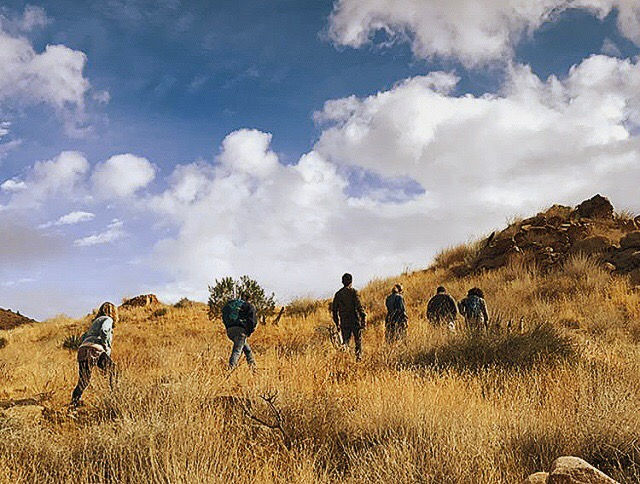Chasing Spring, field botany studies in the Sonoran.
- Christina Every Leaf Speaks Botanical Studies
- Apr 15, 2020
- 4 min read

In early March pre-covidpocalypse I joined a group of Columbines School of Botanical Studies alumni for the Chasing Spring botanical field studies in the Sonoran Desert in Southwestern Arizona and into Mexico. It was an adventure from desert monsoon rain like storms, flash floods, to being off grid away from everyone aside of each other. I was familiar with many of the flora as there were many that occur in the Mojave Desert where I live and the Colorado Desert (a sub-section of the Sonoran Desert) where I was raised and explore much of the flora there being so close to to home. We keyed out many cacti including columnar cacti Stenocereus thurberi commonly known as Organ Pipe and we keyed out keystone cacti of the Sonoran like Carnegiea gigantea commonly known as Saguaro. This was pretty epic of an exploration for me, being in the desert and among the old growth Carnegiea.

On my off time I took copies of the books my partner had printed of the Flora of Southwest Arizona a collaboration written by researchers / botanist Richard Felger, Sue Rutman, Jim Malusa and colleagues. I found myself in a rabbit hole reading before bed and waking early to read more before our field studies began. This is the best dichotomous keys I have ever used, aside of the keys there was more information from ecology to ethnobotanical uses and noting what First Peoples worked with the plants. This information is available online for free as a PDF so check it out if you are a botany, ethnobotanical, ecology geek like we are.

We keyed out several members of Fabaceae (legume family) some of them were Parkinsonia microphylla Yellow Palo Verde and P. florida commonly known as Blue Palo Verde. I find etymology fascinating, I discovered that the genus Parkinsonia was named in honor of English herbalist and botanist John Parkinson (1567 - 1650) who was the herbalist to the King of Scottland, James VI. John Parkinson published two books in his lifetime, Paradisi in Sole Paradisus Terrestris(1629) is often considered to be the the first horticultural book of the flora in England and his second book Theatrum Botanicum(1640), a book of the medicinal flora of England. The books are archived and with some zooming in you can read Parkinson's keys and uses of plants.
Looking at the reduced leaves of P. microphylla which lends to its species name, micro meaning small and phylla meaning leaf. Reduced leaves are a common occurrence of flora in arid regions, even the flora of the Chaparral plant communities, we will find that plants have smaller leaves to even their architecture, some are facing upwards where they will not get direct sun exposure and protection against moisture loss, some theorize that the shape of the leaf is also a way of the leaf cupping water, a perfect example is Rhus ovata commonly known as Sugarbush. It is interesting to observe the plants adaptation to its environment. Because these species are incapable of picking up and moving when it gets too hot or when there is a lack of water or it is too cold these reduce leaves act as a way of protection and insulation. Other forms of protection of having hairs and resins.

If you noticed the stems are green as well as the bark, I just did not get a photo of the bark, being that the leaves are so reduced the bark/stems are capable of photosynthesis! Plants are just so amazing to study.

It made me smile to see a genus was named after an herbalist / botanist. To see that botanist had respect for John Parkinson that they would name a genus after him. I find that some botanist look down on herbalist and I can understand why. I have met some botanist who think of herbalist as people who will destroy the plants by over harvesting and I have heard botanist on podcast who put down herbalist to some degree and some do it in a disrespectful manner which left me having zero respect for that person, one YouTuber botanist said herbalist shove "herbs up our asses", well that person has no personal experience with an herbalist. Many botanist are unaware of the conversational movement by herbalist who spend time educating others on the flora and not for medicinal uses but of conservation. United Plant Savers is one example of medicinal plant conservation organization founded by herbalist that are tirelessly working to save medicinal plants at risk or on the to watch list. Columbines School of Botanical Studies is another good example, this is one of the schools I went to and can speak from experience that Howie Brounstein founder, botanist, herbalist has made this his life's work on educating students along with teaching field botany and ecology. I know there are many folks who wildcraft (wild forage) plants without knowing the plants ID and base it off of morphological similarities or base it off "the plant told me to pick it" well really I can see why botanist and other herbalist like myself find this to be inappropriate and far from being "ethical wildcrafting", if you do not have the proper identification, knowledge of the plants status, picking permit then we should not take of any plant. Check out Columbines Wildcrafting Check List
In defense of herbalist, there are many of us who truly care about the flora and educating ourselves along with others.
Well closing with some beauty, here are some photos of our botanical adventure in the Sonoran.
























Comments